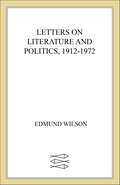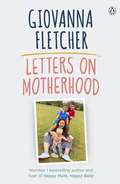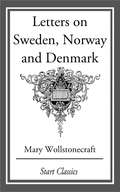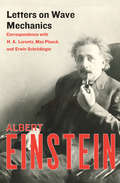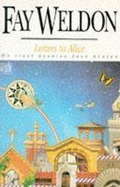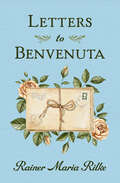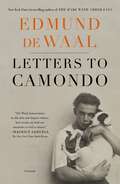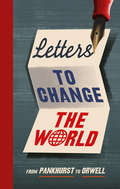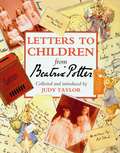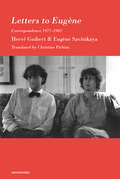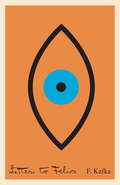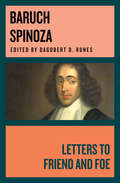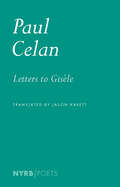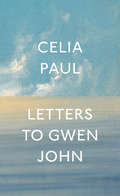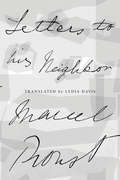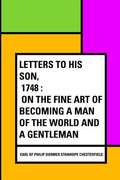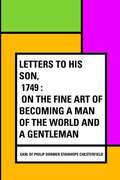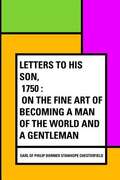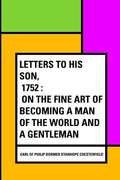- Table View
- List View
Letters on Literature and Politics, 1912–1972
by Edmund WilsonLetters on Literature and Politics, 1912-1972 contains a selection of the literary critic and author Edmund Wilson's personal correspondence.As editor Leon Edel states in his introduction to these papers: "More than a sampling, the present volume provides sufficient material to show the energy and vitality of Wilson's professional relations with friends and acquaintances; it shows even more the continuity of his imaginative life from his youth to the end."
Letters on Motherhood: The heartwarming and inspiring collection of letters perfect for Mother’s Day
by Giovanna FletcherThe heartwarming letters from Giovanna to her husband Tom Fletcher, their three sons, and mothers everywhere - from the bestselling author and host of the No. 1 Happy Mum Happy Baby podcast'Inspiring, beautiful and eye opening. Thank you Giovanna. You've made many mothers feel like they're not alone' 5***** Reader Review'As heartwarming as it is moving' Hello!NOW WITH FOUR EXCLUSIVE NEW LETTERS_______With stories parents everywhere can relate to, Giovanna writes beautiful, poignant and deeply heartfelt letters to everyone who has helped her to become the mother she is today. To her young sons: Buzz, Buddy and Max. To Tom, and her mum and dad. But also, to herself, her body, and more. And finally, to all of the mums, dads and mums-to-be out there doing the work too. These letters cover everything from her fears and hopes to the love and uncertainty of being a mother today. Honest, heartwarming and hilarious, Giovanna's relatable musings on motherhood are both a joy and a comfort, paying testament to the power of family._______'Fantastically honest, witty and real . . . I laughed and cried!' 5***** Reader Review'Giovanna is a real one' Candice Brathwaite, bestselling author of I Am Not Your Baby Mother'Cried, laughed and could relate to nearly every word' 5***** Reader Review'Giovanna is a one of a kind sort of person. She's genuine, talented, and well honestly? I just really like her' Rosie Ramsay, bestselling author of Sh**ged. Married. Annoyed.
Letters on Sweden, Norway and Denmark
by Mary WollstonecraftMary Shelley (née Mary Wollstonecraft Godwin, often known as Mary Wollstonecraft Shelley) was a British novelist, short story writer, dramatist, essayist, biographer, travel writer, and editor of the works of her husband, Romantic poet and philosopher Percy Bysshe Shelley. She was the daughter of the political philosopher William Godwin and the writer, philosopher, and feminist Mary Wollstonecraft. Mary Shelley was taken seriously as a writer in her own lifetime, though reviewers often missed the political edge to her novels. After her death, however, she was chiefly remembered only as the wife of Percy Bysshe Shelley and as the author of Frankenstein. It was not until 1989, when Emily Sunstein published her prizewinning biography Mary Shelley: Romance and Reality, that a full-length scholarly biography analyzing all of Shelley's letters, journals, and works within their historical context was published. The well-meaning attempts of Mary Shelley's son and daughter-in-law to "Victorianise" her memory through the censoring of letters and biographical material contributed to a perception of Mary Shelley as a more conventional, less reformist figure than her works suggest. Her own timid omissions from Percy Shelley's works and her quiet avoidance of public controversy in the later years of her life added to this impression. The eclipse of Mary Shelley's reputation as a novelist and biographer meant that, until the last thirty years, most of her works remained out of print, obstructing a larger view of her achievement. She was seen as a one-novel author, if that. In recent decades, however, the republication of almost all her writings has stimulated a new recognition of its value. Her voracious reading habits and intensive study, revealed in her journals and letters and reflected in her works, is now better appreciated. Shelley's recognition of herself as an author has also been recognized; after Percy's death, she wrote about her authorial ambitions: "I think that I can maintain myself, and there is something inspiriting in the idea". Scholars now consider Mary Shelley to be a major Romantic figure, significant for her literary achievement and her political voice as a woman and a liberal.
Letters on Wave Mechanics: Correspondence with H. A. Lorentz, Max Planck, and Erwin Schrödinger
by Albert EinsteinA lively collection of Einstein&’s groundbreaking scientific correspondence on modern physics Imagine getting four of the greatest minds of modern physics in a room together to explain and debate the theories and innovations of their day. This is the fascinating experience of reading Letters on Wave Mechanics, the correspondence between H. A. Lorentz, Max Planck, Erwin Schrödinger, and Albert Einstein. These remarkable letters illuminate not only the basis of Schrödinger&’s work in wave mechanics, but also how great scientific minds debated and challenged the ever-changing theories of the day and ultimately embraced an elegant solution to the riddles of quantum theory. Their collected correspondence offers insight into both the personalities and professional aspirations that played a part in this theoretical breakthrough. This authorized ebook features rare photos and never-before-seen documents from the Albert Einstein Archives at the Hebrew University of Jerusalem.
Letters on Wave Mechanics: Correspondence with H. A. Lorentz, Max Planck, and Erwin Schrödinger (Paperback Ser.)
by Albert EinsteinA lively collection of Einstein&’s groundbreaking scientific correspondence on modern physics Imagine getting four of the greatest minds of modern physics in a room together to explain and debate the theories and innovations of their day. This is the fascinating experience of reading Letters on Wave Mechanics, the correspondence between H. A. Lorentz, Max Planck, Erwin Schrödinger, and Albert Einstein. These remarkable letters illuminate not only the basis of Schrödinger&’s work in wave mechanics, but also how great scientific minds debated and challenged the ever-changing theories of the day and ultimately embraced an elegant solution to the riddles of quantum theory. Their collected correspondence offers insight into both the personalities and professional aspirations that played a part in this theoretical breakthrough. This authorized ebook features rare photos and never-before-seen documents from the Albert Einstein Archives at the Hebrew University of Jerusalem.
Letters on an Elk Hunt By a Woman Homesteader
by Elinore P. Stewart Elizabeth F. FerrisA continuation of Letters of a Woman Homesteader, Letters on an Elk Hunt is set in the same corner of southwestern Wyoming, the time is the fall of 1914, and (despite the title) Mrs. Stewart is far less concerned with elk hunting than with people—old friends and new acquaintances—and with the land in which she found so much beauty. Her letters, as Jessamyn West said of the earlier volume, "are, in fact (though not that alone), a collection of short stories. " She added that "what makes these letters so good are not these stories, but the character of the storyteller, of Elinore Stewart herself. Her letters endure and give pleasure because she does what the great letter-writers do: she reveals herself. . . . It is the woman in this vanished landscape, the homesteader with her enormous vitality, humor, and tenderness who holds our attention. " Jessamyn West's wish to know more about the author herself is fulfilled in the foreword to Letters on an Elk Hunt—an appreciative biographical sketch, incorporating material from some of Mrs. Stewart's unpublished letters as well as the reminiscences of her children. Elizabeth Fuller Ferris, of the Wilderness Women Project, Missoula, Montana, is the writer and producer of Burntfork, a film for public television funded by the National Endowment for the Humanities based upon the life of Elinore Pruitt Stewart.
Letters to Alice on First Reading Jane Austen: On First Reading Jane Austen
by Fay WeldonAlice is an eighteen-year-old student and aspiring novelist with green spiky hair, a child of the modern age who recoils at the idea of reading Jane Austen. In a sequence of letters reminiscent of Jane Austen’s to her own neice, ‘aunt’ Fay examines the rewards of such study. Not only is her correspondence a revealing tribute to a great writer – it is also an original and rewarding exploration of the craft of fiction itself.
Letters to Benvenuta
by Rainer Maria RilkeThis collection of letters by the renowned Austrian poet offers a rare glimpse into his private life and his relationship with the woman he called Benvenuta.In January of 1914, Rainer Maria Rilke received his first letter from a Viennese correspondent who had discovered his story collection, Tales of the Dear Lord God. A sudden and intense exchange of letters followed which would eventually put the famous poet in touch with the woman he would never meet. Nearing forty and separated from his wife, Rilke was ill and depressed when his correspondence with Magda von Hattingberg began. A concert pianist many years younger, she was also alone. Von Hattingberg told the story of their brief but dramatic attachment in her book Rilke and Benvenuta. Now their story is made complete with Letters to Benvenuta, a series of letters written by Rilke during a sojourn in Paris.
Letters to Camondo
by Edmund de WaalA tragic family history told in a collection of imaginary letters to a famed collector, Moise de CamondoLetters to Camondo is a collection of imaginary letters from Edmund de Waal to Moise de Camondo, the banker and art collector who created a spectacular house in Paris, now the Musée Nissim de Camondo, and filled it with the greatest private collection of French eighteenth-century art.The Camondos were a Jewish family from Constantinople, “the Rothschilds of the East,” who made their home in Paris in the 1870s and became philanthropists, art collectors, and fixtures of Belle Époque high society, as well as being targets of antisemitism—much like de Waal's relations, the Ephrussi family, to whom they were connected. Moise de Camondo created a spectacular house and filled it with art for his son, Nissim; after Nissim was killed in the First World War, the house was bequeathed to the French state. Eventually, the Camondos were murdered by the Nazis.After de Waal, one of the world’s greatest ceramic artists, was invited to make an exhibition in the Camondo house, he began to write letters to Moise de Camondo. These fifty letters are deeply personal reflections on assimilation, melancholy, family, art, the vicissitudes of history, and the value of memory.
Letters to Change the World: From Emmeline Pankhurst to Martin Luther King, Jr.
by Travis Elborough‘We know through painful experience that freedom is never voluntarily given by the oppressor; it must be demanded by the oppressed’ Martin Luther KingIn an era where the liberties we often take for granted are under threat, Letters To Change the World is a collection of inspiring letters offering reminders from history that standing up for and voicing our personal and political beliefs is not merely a crucial right but a duty if we want to change the world.Edited by Travis Elborough, the collection includes George Orwell's warning on totalitarianism, Martin Luther King's 'Letter from a Birmingham Jail', Albert Camus on the reasons to fight a war, Bertrand Russell on peace, Emmeline Pankhurst rallying her suffragettes, Nelson Mandela's letter to his children from prison and Time's Up on the abuse of power.
Letters to Children from Beatrix Potter
by Judy Taylor'My dear Noel, I don't know what to write to you so I shall tell you a story about four little rabbits whose names were - Flopsy, Mopsy, Cottontail and Peter.' So begins Beatrix Potter's most celebrated letter, in which she tells for the first time the story that was destined to make her name famous all over the world, The Tale of Peter Rabbit. It was written to cheer up a sick little boy when he was ill, and is one of numerous surviving letters written by Beatrix Potter to entertain individual children. Sometimes her letters take the form of a supposed correspondence between different animal characters from the stories, each written in miniature with its own tiny envelope.
Letters to Eugène: Correspondence 1977–1987 (Semiotext(e) / Native Agents)
by Herve Guibert Eugene SavitzkayaHervé Guibert's incandescent correspondence with Belgian poet Eugène Savitzkaya.In 1977, Hervé Guibert discovered the first novel written by Eugène Savitzkaya, Mentir, and sent him his La mort propagande, which had just been published. In the following years, they exchanged the books they had written, read each other, appreciated each other. They saw each other rarely, however: one lived in Liège, the other Paris. A turning point occurred in 1982, when Hervé published "Lettre à un frère d&’écriture," in which he declared to Eugène, "I love you through your writing." The tone had changed; Hervé, obsessed with his correspondent, wrote him increasingly incandescent letters. 1984 would, however, see the sudden extinguishing of that passion. A deep friendship replaced it, which found itself with new areas to explore: the adventure of publishing L&’Autre Journal and at the Villa Medicis, where they were both fellows. These nearly eighty letters, exchanged between 1977 and 1987, form a correspondence that is all the more unique for being the only one whose publication was authorized by Guibert. An intersection of life and writing, self and other, reality and fiction, their release is a renewal of Guibert&’s oeuvre.
Letters to Felice
by Franz KafkaFranz Kafka first met Felice Bauer in August 1912, at the home of his friend Max Brod. The twenty-five-year-old career woman from Berlin--energetic, down-to-earth, life-affirming--awakened in him a desire to marry. Kafka wrote to Felice almost daily, sometimes even twice a day. Because he was living in Prague and she in Berlin, their letters became their sole source of knowledge of each other. But soon after their engagement in 1914, Kafka began having doubts about the relationship, fearing that marriage would imperil his dedication to writing and interfere with his need for solitude. Through their break-up, a second engagement in 1917, and their final parting later that year, when Kafka began falling ill with the tuberculosis that would eventually claim his life, their correspondence continued. The more than five hundred letters that Kafka wrote to Felice over the course of those five years were acquired by Schocken from her in 1955. They reveal the full measure of Kafka's inner turmoil as he tried, in vain, to balance his need for stability with the demands of his craft."These letters are indispensable for anyone seeking a more intimate knowledge of Kafka and his fragmented world."--Library Journal
Letters to Felice
by Franz KafkaFranz Kafka first met Felice Bauer in August 1912, at the home of his friend Max Brod. The twenty-five-year-old career woman from Berlin--energetic, down-to-earth, life-affirming--awakened in him a desire to marry. Kafka wrote to Felice almost daily, sometimes even twice a day. Because he was living in Prague and she in Berlin, their letters became their sole source of knowledge of each other. But soon after their engagement in 1914, Kafka began having doubts about the relationship, fearing that marriage would imperil his dedication to writing and interfere with his need for solitude. Through their break-up, a second engagement in 1917, and their final parting later that year, when Kafka began falling ill with the tuberculosis that would eventually claim his life, their correspondence continued. The more than five hundred letters that Kafka wrote to Felice over the course of those five years were acquired by Schocken from her in 1955. They reveal the full measure of Kafka's inner turmoil as he tried, in vain, to balance his need for stability with the demands of his craft."These letters are indispensable for anyone seeking a more intimate knowledge of Kafka and his fragmented world."--Library Journal
Letters to Friend and Foe
by Baruch SpinozaLetters that appear in this volume cover only the last two decades of Spinoza&’s life and represent a mere fraction of the immense correspondence he carried on during his lifetime.
Letters to Friend and Foe
by Baruch SpinozaLetters that appear in this volume cover only the last two decades of Spinoza&’s life and represent a mere fraction of the immense correspondence he carried on during his lifetime.
Letters to Friends, Family, and Editors (The Schocken Kafka Library)
by Franz Kafka"These magnificent letters, meticulously set up and annotated, show us aspects of Kafka that were only hinted at in earlier collections and help us trace his development from unhappy young law student and insurance administrator to novelist and short-story writer of originality and genius."--Publishers Weekly"When we turn from Kafka's books to his letters we have a series of self-portraits desperate and courageous, always eager and warm in feeling; the self is lit by fantasy and, of course, by drollery. His candor is of the kind that flies alongside him in the air. He was a marvelous letter writer."--V.S. Pritchett, The New York Review of Books"These letters are like messages from the underground, from the dark side of the moon, presenting aspects of Kafka that would have died with his friends. We meet alternately Kafka the artist, friend, son, father figure, marriage counselor, literary critic, insurance official. . . . A full portrait, and a significant contribution to Kafka scholarship."--Smithsonian Magazine"An inside view of a writer who, perhaps more than any other novelist or poet in our century, stands at the center of our culture."--Robert Alter, The New York Times Book Review
Letters to Gisèle: 19511970
by Paul CelanInsightful and provocative letters by a great twentieth-century poet to his artist wife about life and, revealingly, his own writing. An intimate look at this canonical poet's process, mental health, and quotidian moments during the early 1950s.One of the most significant European poets of the twentieth century, Paul Celan came from an Eastern European Jewish family and lost his parents to the death camps of World War II. Transplanted to Paris, he produced a body of work that was an ongoing confrontation with that history of loss and with the German language. His poems, anguished and unsleeping, have by now been translated into many languages, becoming a touchstone for poets, writers, and philosophers.Letters to Gisèle presents the letters Celan wrote to his wife, the French visual artist Gisèle Celan-Lestrange, over the course of close to twenty years, along with letters to the couple&’s son, Eric, and letters from Gisèle to Paul. They provide an intimate view of his literary career and troubled life, which was marked by repeated stays in psychiatric clinics. They also provide an unparalleled glimpse into Celan&’s poetic workshop, including his own word-for-word renderings from German into French of more than a dozen of his poems. These he addressed to Gisèle as an ongoing, informal German lesson. They figure too as messages from the heart. Presented here trilingually, these overlapping versions of Celan&’s poems open up new dimensions of his famously hermetic poetry, as dazzling as it is dark. This edition includes some poems in the original German and Celan's own translations of them.
Letters to Gwen John
by Celia PaulWith original artworks throughout, an extraordinary fusion of memoir and artistic biography from the acclaimed artist and author of Self-Portrait.Dearest Gwen, I know this letter to you is an artifice. I know you are dead and that I&’m alive and that no usual communication is possible between us but, as my mother used to say, &“Time is a strange substance&” and who knows really, with our time-bound comprehension of the world, whether there might be some channel by which we can speak to each other, if we only knew how.Celia Paul&’s Letters to Gwen John centers on a series of letters addressed to the Welsh painter Gwen John (1876–1939), who has long been a tutelary spirit for Paul. John spent much of her life in France, making art on her own terms and, like Paul, painting mostly women. John&’s reputation was overshadowed during her lifetime by her brother, Augustus John, and her lover Auguste Rodin. Through the epistolary form, Paul draws fruitful comparisons between John&’s life and her own: their shared resolve to protect the sources of their creativity, their fierce commitment to painting, and the ways in which their associations with older male artists affected the public&’s reception of their work.Letters to Gwen John is at once an intimate correspondence, an illuminating portrait of two painters (including full-color plates of both artists&’ work), and a writer/artist&’s daybook, describing Paul&’s first exhibitions in America, her search for new forms, her husband&’s diagnosis of cancer, and the onset of the global pandemic. Paul, who first revealed her talents as a writer with her memoir, Self-Portrait, enters with courage and resolve into new unguarded territory—the artist at present—and the work required to make art out of the turbulence of life.
Letters to His Neighbor
by Marcel Proust Lydia DavisBrilliantly translated by Lydia Davis, here are Proust’s tormented, touching, and often very funny letters to his noisy neighbor. Marcel Proust’s genius for illuminating pain is on spectacular display in this recently discovered trove of his correspondence, Letters to His Neighbor. Already suffering from noise within his cork-lined walls, his poor soul was not ready for the fresh hell when his neighbor Dr. Williams married a widow with small children. Chiefly to Mrs. Williams, these ever-polite letters (often accompanied by flowers, compliments, books, even pheasants) are frequently hilarious—Proust couches his fury in a gracious tone. In Lydia Davis’s hands, the digressive brilliance of his sentences shines: “Don't speak of annoying neighbors, but of neighbors so charming (an association of words contradictory in principle since Montesquiou claims that most horrible of all are 1) neighbors 2) the smell of post offices) that they leave the constant tantalizing regret that one cannot take advantage of their neighborliness.” Proust makes fine distinctions among his auditory torments: “The valet de chambre makes noise and that doesn't matter. But later he knocks with little tiny raps. And that is worse.” Lydia Davis has written a generous translator’s note, tracing much of what we can know about Proust’s perpetually dark room; she details the furnishings as well as the life he lived there: burning his powders, talking with friends, hiring musicians, and, most of all, suffering. Letters to His Neighboris richly illustrated with facsimile letters and photographs—catnip for lovers of Proust. With an Introduction by Jean-Yves Tadié and a translator’s note by Lydia Davis.
Letters to His Son, 1746-47 / On the Fine Art of Becoming a Man of the World and a Gentleman
by Earl of Philip Dormer Stanhope ChesterfieldEarl of Philip Dormer Stanhope Chesterfield was an 18th century British aristocrat best known for his wit and for being a man of letters. His works offer a great insight into what life was like during the time period in England.
Letters to His Son, 1748 / On the Fine Art of Becoming a Man of the World and a Gentleman
by Earl of Philip Dormer Stanhope ChesterfieldEarl of Philip Dormer Stanhope Chesterfield was an 18th century British aristocrat best known for his wit and for being a man of letters. His works offer a great insight into what life was like during the time period in England.
Letters to His Son, 1749 / On the Fine Art of Becoming a Man of the World and a Gentleman
by Earl of Philip Dormer Stanhope ChesterfieldEarl of Philip Dormer Stanhope Chesterfield was an 18th century British aristocrat best known for his wit and for being a man of letters. His works offer a great insight into what life was like during the time period in England.
Letters to His Son, 1750 / On the Fine Art of Becoming a Man of the World and a Gentleman
by Earl of Philip Dormer Stanhope ChesterfieldEarl of Philip Dormer Stanhope Chesterfield was an 18th century British aristocrat best known for his wit and for being a man of letters. His works offer a great insight into what life was like during the time period in England.
Letters to His Son, 1752 / On the Fine Art of Becoming a Man of the World and a Gentleman
by Earl of Philip Dormer Stanhope ChesterfieldEarl of Philip Dormer Stanhope Chesterfield was an 18th century British aristocrat best known for his wit and for being a man of letters. His works offer a great insight into what life was like during the time period in England.
